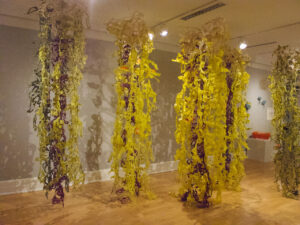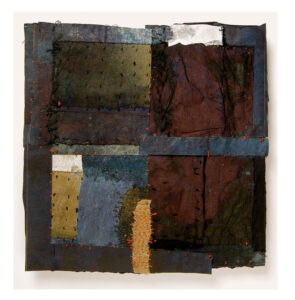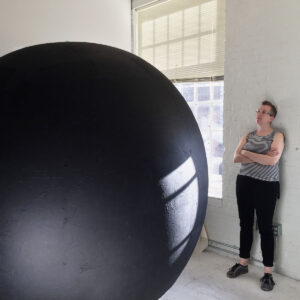Textile Talk: The Potential of Paper – Audience Questions Answered
October 14, 2020
SDA hosted the online event The Potential of Paper: Fiber Artists, Papermakers and Sculptural Form, A Conversation with Jocelyn Chateauvert (JC), Fafnir Admamites (FA) and Mary Hark (MH), as part of Textile Talks on September 23, 2020. With 681 in the audience, many questions were left unanswered. We are delighted to be able to answer them here. The event recording is available on SDA’s Vimeo Channel. As one participant said, wow!!! that’s all I can say about all three! thank you!

Jocelyn Chateauverts, Mary Hark, Fafnir Admamites
What fibers do you mostly use to make paper?
JC: Abaca (which starts out white); flax
MH: Flax, linen, abaca, Asian fibers, textile waste
FA: I typically use overbeaten abaca for my pulp dipped sculptures. The large orb pieces were made using sheets of fine mulberry paper.
Do you finish the paper with anything?
JC: No, -no glue, varnish or sizing
MH: I gelatin size papers that are dyed after they are formed, to seal the dye.
Can you describe pigments or inks used?
All three artists color the paper during creation, using papermaking pigments, such as Aardvark aqueous disperse pigments sold by Carriage House Paper. They are mixed directly into the wet paper pulp and are light fast. MH also uses natural dyes such as walnut, indigo, etc. which have the same fastness on paper as they would on cloth. JC uses high quality inks for drawing. She says her paper pieces are relatively light fast. “In 30 years, about 10% fading when placed in sunny location.”
How do you move, store and ship the larger forms or installations?
JC I create work with modular components and use standard archival storage.
MH: My large works just roll up like a textile.
FA: The large hollow paper forms are folded and stored in large bags after an installation. I started this technique to save money on shipping/transportation and because I don’t have space to store things this size. I knew I wanted to make large pieces but I needed to come up with some practical solutions to make it more feasible.
Do you protect your pieces from moisture and forces that can affect them?
All: No. These are very thick papers and a variety of manual methods can be used to clean them
Can you recommend books?
JC: I did not learn from books, but by the tactile experience of doing. JC recommends the wealth of information on YouTube.
MH: Both of Tim Barrett’s books (Japanese Papermaking and European Hand Papermaking: Traditions, Tools, and Techniques); plus anything by Helen Hiebert
FA: Papermakers Companion by Helen Hiebert is a classic
Questions specifically for Jocelyn:
What thread and needle size work to sew paper together?
Nylon thread, primarily #16 needle- I change them often due to dullness and use a 1960s vintage sewing machine.
How do you prevent your paper from becoming perforated while sewing?
Sometimes it is perforated.
Is there a substrate under the paper?
No, by design, handmade paper often has a different surface and texture than regular smooth store-bought papers.
Do you get a different result if you use a vacuum table vs air dry?
All methods see a high rate of shrinkage, over 25%. Air dry 6-7 days, depending on thickness. Using a vacuum table means less drying time.
Can you talk about the business end of your work, getting commissions, etc.
JC mostly works with architects and applies for projects. “I’m all about the making”, she says.

Jocelyn Chateauvert Kelp Totems
Questions specifically for Mary:
How was the beater made with the bicycle?
The beater was designed by Lee MacDonald, Tools for Paper.
If one doesn’t have a professional beater, will a home blender work to make the abaca pulp?
A home blender will chop up botanicals from your garden (see Helen Hiebert’s book Papermaking with Garden Plants and Common Weeds) However you need a Hollander beater to process abaca, flax and textile waste.
How do you attach pieces of paper to each other in your constructed paintings?
Sewing, PVA glue, an archival bookbinders glue.
Is flax available for sale from the farm in Nova Scotia?
Yes, please visit the Canadian source, Taproot Fibre Lab.
Please comment on your natural dyes. My concern with natural dyes is how fugitive they are when exposed, such as in a wall piece, or anything that is not in a closed environment, such as a book.
Natural dyes on paper have the same lifespan as natural dyes on a textile.

Mary Hark Close to Home #1
Questions specifically for Fafnir:
Do you use a Hollander beater?
No, I do not have a Hollander beater, but I hope to one day. I buy beaten pulp from Carriage House Papers. They ship it, mostly drained, in 5-gallon buckets.
Does the paper pulp readily adhere to the underlying substrate (cotton string, wire, etc.)?
The pulp adheres easily to fiber materials like string, or materials that have a bit of “tooth”. Smoother surfaces like wire often need a few dips to become fully covered because the pulp often slides off.

Fafnir Adamites
– Astrid Hilger Bennett is SDA President and was the moderator of this Textile Talk. She maintains a studio practice in Iowa City, IA.



3 Comments
Barbara McCaffrey says
October 14, 2020 at 8:07 am
This was wonderful Astrid. It answered the things I was curious about. Great papermaking references too!
Christine Aaron says
October 16, 2020 at 10:40 am
Thank you for compiling these!
Brenda Parsons says
October 26, 2020 at 1:37 am
I really enjoyed this discssion and work. Thank you. Member of IAPMA International Association of Paper makers and Artists
Related Blog Articles
No related blog articles yet.